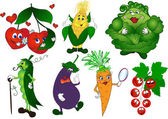Can BIG FOOD Inc. Be Trusted?
Author: Dr. Stephen Chaney
 Healthy Eating Is In. We are told we need more fiber, whole grains, fruits & vegetables, nuts and omega-3s in our diet. As a consequence more and more Americans are reading food labels to be sure that the foods they are buying are healthy.
Healthy Eating Is In. We are told we need more fiber, whole grains, fruits & vegetables, nuts and omega-3s in our diet. As a consequence more and more Americans are reading food labels to be sure that the foods they are buying are healthy.
But are those food labels deceptive? Is it possible that BIG FOOD Inc. could actually be lying to us? Could it be that the food manufacturers care more about their profits than about our health?
Normally I base my health tips on clinical studies published in peer-reviewed scientific journals. However, this week I am reporting on an article called “Hijacked. How the Food Industry Turns Diet Advice into Profits” from the October 2014 issue of Nutrition Action Health letter because they do an excellent job of exposing the lies of the food industry.
The Food Label: The Lies of the Food Industry
False Fiber
 For example, Nutrition Action describes how the food industry tries to fool us into thinking that their processed foods are healthy by making fiber claims on their labels that are deceptive, if not downright false.
For example, Nutrition Action describes how the food industry tries to fool us into thinking that their processed foods are healthy by making fiber claims on their labels that are deceptive, if not downright false.
Everyone knows that eating fiber rich foods like fruits, vegetables, whole grains, and legumes is good for us. But wouldn’t it be more fun if you could get the same amount of fiber in your breakfast bars, cakes, cookies and even yoghurt?
The food manufacturers are only too happy to oblige. DuPont, for example, manufacturers and artificial fiber called Litesse by chemically linking glucose (dextrose) molecules into a non-digestible polydextrose polymer. They tell the food manufacturers that they can use Litesse to “tap into this market opportunity and project a healthier image for your product”. I’d be much more impressed if they were talking about a healthier product rather than a “healthier image for your product” It’s all about image, isn’t it.
Similarly, Archer Daniels Midland manufactures a digestion-resistant form of maltodextrin they call Fibersol-2. They tell food manufacturers “who knew fiber could be clean and clear?” (Translation: Adding bran to your products might make them denser and chewier. You can add Fibersol-2 to your doughnuts or cookies and it won’t change their taste or texture).
The problem is that there are few clinical studies showing that these artificial fibers have the same benefits as the fibers we find in fresh fruits, vegetables and whole grains. In addition, these fibers don’t fill you up the way that unprocessed fibers found in foods do (something we scientists refer to as satiety). For example, if you eat a bowl of oatmeal you’re not going to be hungry for a long time. However, recent studies show that adding an equivalent amount of one of these artificial fibers to a muffin or breakfast bar has no effect on how hungry you feel after eating it.
Nutrition Action also raised concerns about highly processed natural fibers such as inulin, maltodextrin, soluble corn fiber or resistant wheat starch. In this situation, they may be oversimplifying their messaging a bit. I agree with their statement that adding these purified fibers to solid foods like cookies or muffins has relatively little effect on either satiety or regularity, but these fibers do have some benefits when used in the right kinds of foods.
For example, inulin is an excellent prebiotic. Its addition to processed foods as a prebiotic, rather than a source of fiber, is appropriate. Maltodextrin needs to be digested before its component sugars are absorbed into the bloodstream, so it enters the bloodstream a bit more slowly than simple sugars. When used in sports drinks it helps stabilize blood sugar and provide more sustained energy. Similarly, the addition of soluble corn starch to a protein shake slows gastric emptying, which also stabilizes blood sugar and provides sustained energy. Wheat bran in a protein shake, on the other hand, would be an inappropriate choice. It would just settle to the bottom of the glass.
The Bottom Line: The best place to get your fiber is from fresh fruits, fresh vegetables, and whole grains. Before you reach for a processed food that claims to be high in fiber read the label carefully. Make sure that fiber comes from foods rather than artificial fibers. If the main fiber ingredient is a processed fiber, make sure that the type of fiber is appropriate for the food you are consuming.
Vegetable & Fruit Follies
 Everyone knows that fruits and vegetables are good for us. They are chock-full of vitamins, minerals, and phytonutrients as well as fiber. But who wants to spend the time peeling an orange or washing the pesticides off that broccoli? It’s much more fun to get our fruits and vegetables from chips, pasta, and breakfast cereals.
Everyone knows that fruits and vegetables are good for us. They are chock-full of vitamins, minerals, and phytonutrients as well as fiber. But who wants to spend the time peeling an orange or washing the pesticides off that broccoli? It’s much more fun to get our fruits and vegetables from chips, pasta, and breakfast cereals.
Once again, the food manufacturers are only too happy to oblige. The chemical companies make a variety of fruit and vegetable powders that food manufacturers can add to their products. For example, PowderPure tells food manufacturers “Whether you want to add nutrition to your label, infuse full color or formulate a specific flavor profile for your discerning consumers, PowderPure has the right powder to enhance your presence in the marketplace”. You will notice they are talking about adding nutrition to the label, not to the food. They are talking about “enhancing your presence in the marketplace”, not making your food healthier.
The problem is that sprinkling a little fruit and vegetable powder into a processed food will never provide the full range of nutrients that those fruits and vegetables would have provided.
Most manufacturers can’t (or won’t) specify the amounts of nutrients and phytonutrients you get from the fruit & vegetable powders they add to their processed foods, but that doesn’t stop them from making label claims like “We pop a flavorful blend of nine veggies…[in our chips]” or there is “half serving of vegetables in a 2 oz serving…[of our pasta]”.
The Bottom Line: Ignore the label claims of fruits and vegetables added to the processed foods you see in the market. The fruit and vegetable powders added to those foods provide no proven benefit. The best place to get your fruits and vegetables is to [surprise] eat your fruits and vegetables.
The Fruits & Vegetables in a Capsule Con
 One of my pet peeves is the food supplement manufacturers who try to tell you that they have concentrated a cornucopia of fresh fruits and vegetables in a capsule. For example, one company claims that their capsules contain apple, barley, broccoli, beet, cabbage, carrot, cranberry, date, garlic, kale, oats, orange, parsley, peach, pineapple, prunes, spinach, plant enzymes, fiber, and acidophilus. All this in one capsule!
One of my pet peeves is the food supplement manufacturers who try to tell you that they have concentrated a cornucopia of fresh fruits and vegetables in a capsule. For example, one company claims that their capsules contain apple, barley, broccoli, beet, cabbage, carrot, cranberry, date, garlic, kale, oats, orange, parsley, peach, pineapple, prunes, spinach, plant enzymes, fiber, and acidophilus. All this in one capsule!
While this list sounds impressive, you need to ask whether they are providing meaningful amounts of those fruits and vegetables. For example, the product claims to have oats. A serving of oats is equal to 1/3 cup dry oats and weighs about 28 grams. A capsule typically weighs about 0. 5 grams. Therefore, to get the equivalent of one serving of oats from a capsule, you would have to consume 56 capsules! And that’s assuming that the entire capsule was filled with oats.
Broccoli is another claimed ingredient. A serving of fresh broccoli weighs 88 grams, but roughly 80 grams of that is water. So if you dehydrated the broccoli you would be left with about 8 grams of material. Therefore, to get a single serving of dehydrated broccoli you would have to consume 16 capsules. Again, that’s assuming that the capsules were completely filled with just broccoli.
You can do this kind of calculation with each ingredient they claim is in their capsules. But when you add up the number of capsules needed to get a reasonable amount of each of these ingredients, the capsule total is staggering.
As for essential nutrients, when you read the label you usually discover that their capsules only contain small amounts of a few essential nutrients. They simply do not provide significant amounts of the vitamins, minerals, and phytonutrients you would have been getting if you ate the real foods.
The Bottom Line: Leave those supplements claiming to have concentrated lots of fruits and vegetables into a single capsule on the shelf. Those claims are grossly deceptive because the capsules do not contain significant amounts of the fruits and vegetables listed on the label. They do not provide the nutrients you would have gotten if you had eaten the real foods. Once again, the best way to get the fruits and vegetables you need in your diet is to actually eat fresh fruits and vegetables.
Omega Oops
 Omega-3 fatty acids are in fashion, so omega-3 claims are springing up everywhere. You can find omega-3 enriched eggs, milk, juices, bars, and even pasta. I won’t address the controversies about omega-3 benefits in this article because I have written about them previously (“Is Fish Oil Really Snake Oil?” , “Can Fish Oil Make Children Smarter?” , or “Do Omega-3s Slow Cognitive Decline?”.
Omega-3 fatty acids are in fashion, so omega-3 claims are springing up everywhere. You can find omega-3 enriched eggs, milk, juices, bars, and even pasta. I won’t address the controversies about omega-3 benefits in this article because I have written about them previously (“Is Fish Oil Really Snake Oil?” , “Can Fish Oil Make Children Smarter?” , or “Do Omega-3s Slow Cognitive Decline?”.
The other point that Nutrition Action made was that the amount of omega-3s provided by these omega-3 enriched foods was seldom enough to provide any significant health benefit. It is the long chain omega-3 fatty acids such as EPA and DHA that are thought to provide the health benefits. The American Heart Association recommends 500 mg/day of these long chain fatty acids for people who have no history of heart disease, and over 1,000 mg/day for people with prior history of heart disease. In that context the few mg of long chain omega-3s provided by most omega-3 enriched foods is a drop in the bucket.
The story is even more tenuous for those manufacturers who add the short chain omega-3 fatty acid ALA, which is found in most vegetable oils and plant seed oils, to their products. That’s because the efficiency of conversion of short chain to long chain fatty acids in the body is only 10-15% for most people. One tablespoon of canola or soy oil provides about 1,000 mg of ALA. Once again, those products providing only a few mg of short chain omega-3s provide little benefit.
When asked why they added omega-3s to their pasta, one manufacturer said “We have to because of the competition”, not “We wanted to make our product healthier”.
The Bottom Line: Avoid those omega-3 enriched processed foods that provide only a few mg of omega-3 fatty acids, especially if their source of omega-3 fatty acids is listed as ALA, vegetable oils or plant seed oils. The best place to get your omega-3s in the amounts that you need is still cold water fish and fish oil supplements.
The Bottom Line
The October 2014 issue of Nutrition Action Healthletter exposed many of the deceptive labeling practices that food manufacturers use to make their products seem healthier than they are. In particular:
- The best place to get your fiber is from fresh fruits, fresh vegetables, and whole grains. Before you reach for a processed food that claims to be high in fiber, read the label carefully. Make sure that fiber comes from foods rather than artificial fibers. If the main fiber ingredient is a processed fiber, make sure that the type of fiber is appropriate for the food you are consuming.
- Ignore the label claims of fruits and vegetables added to the processed foods you see in the market. The fruit and vegetable powders added to those foods provide no proven benefit. The best place to get your fruits and vegetables is to [surprise] eat your fruits and vegetables.
- Leave those supplements claiming to have concentrated lots of fruits and vegetables into a single capsule on the shelf. Those claims are grossly deceptive because the capsules do not contain significant amounts of the fruits and vegetables listed on the label and do not provide the nutrients you would have gotten if you ate the real foods. Once again, the best way to get the fruits and vegetables you need in your diet is to actually eat fresh fruits and vegetables.
- Avoid those omega-3 enriched processed foods that provide only a few mg of omega-3 fatty acids, especially if their source of omega-3 fatty acids is listed as ALA, vegetable oils or plant seed oils. The best place to get your omega-3s in the amounts that you need is still cold water fish and fish oil supplements.
These statements have not been evaluated by the Food and Drug Administration. This information is not intended to diagnose, treat, cure or prevent any disease.
